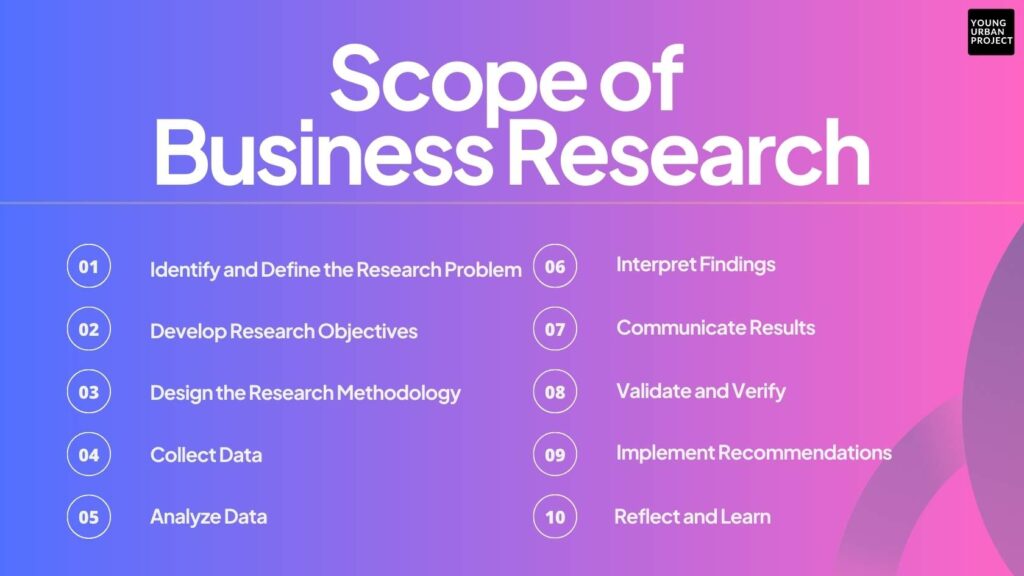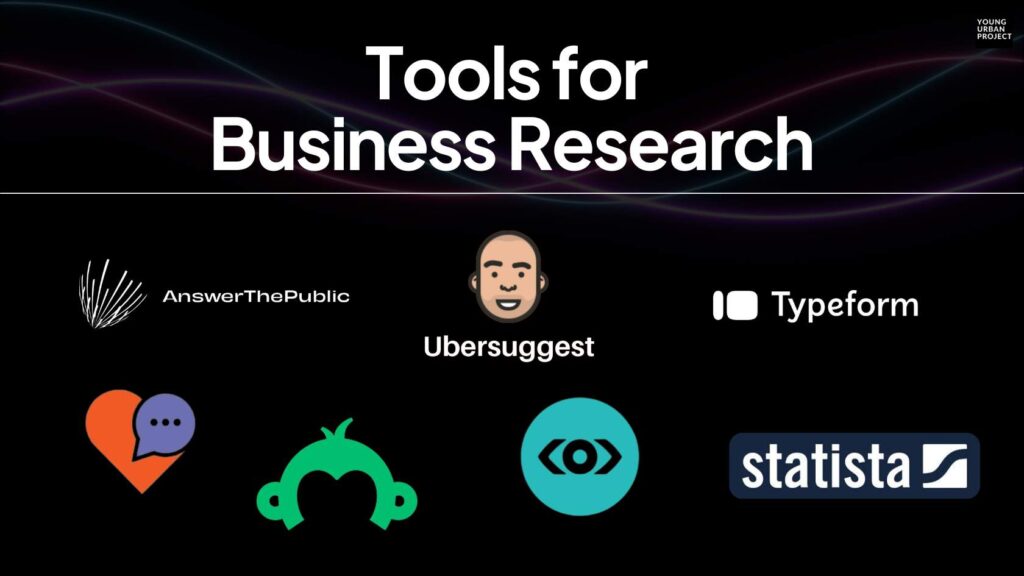Navigating the modern business environment requires more than intuition; it demands precise data and actionable insights. This is where the business research becomes indispensable. From analyzing market trends to understanding consumer behavior, business research serves as a foundation for informed decision-making.
Imagine you’re about to launch a product into a competitive market. How confident would you be in your decisions? Business research is the linchpin that transforms guesswork into data-driven strategies, making your decisions precise, impactful, and profitable. From identifying market trends to shaping future strategies, the scope of business research is vast and pivotal. Let’s look at how it shapes the corporate world.
Table of Contents
What is Business Research?
Business research is the systematic process of gathering, analyzing, and interpreting data to make informed decisions that enhance an organization’s operations, strategies, and market performance. It acts as the backbone of decision-making, providing businesses with insights about their customers, competitors, market trends, and operational challenges.
Key Aspects of Business Research:
- Problem-Solving Tool:
Business research identifies and addresses critical issues, such as understanding customer needs, entering new markets, or improving product offerings. It provides a clear roadmap to address these challenges effectively and develop customer-centric products. - Decision-Making Support:
Whether deciding on a marketing strategy, launching a product, or streamlining operations, business research offers reliable data to back decisions. This reduces risks and increases the likelihood of achieving desired outcomes. - Market Insights:
Research helps organizations understand their target audience, their preferences, and evolving market dynamics. It ensures businesses stay relevant by adapting to changes in consumer behavior and industry trends. - Types of Questions Answered:
- Who are our customers?
- What are their purchasing habits?
- How is our brand perceived compared to competitors?
- What factors are driving industry trends?
- Scope Across Sectors:
Business research applies to a variety of areas, including marketing, operations, finance, human resources, and strategic planning. Each domain uses specific research techniques tailored to its goals.
What is Involved in Business Research?
Business research involves a series of well-structured steps to systematically gather, analyze, and interpret information. This process provides actionable insights to address business challenges or capitalize on opportunities. Here’s an elaboration on the key elements involved:
1. Identifying the Research Problem
The starting point of business research is defining a clear and specific problem or opportunity to explore. This involves narrowing down broad questions into focused areas that are relevant and feasible to investigate.
2. Setting Research Objectives
Research objectives outline what the study aims to achieve. They act as a guide throughout the research process, ensuring alignment with the business’s goals. Objectives must be measurable, specific, and actionable to serve as benchmarks for success.
3. Designing the Research Methodology
This involves selecting appropriate research methods and tools. The methodology defines whether qualitative, quantitative, or mixed methods will be used, and outlines data collection techniques. It also ensures the research approach is aligned with the objectives and resources available.
4. Data Collection
Data collection is the process of gathering relevant and reliable information to address the research objectives. It can be primary (directly collected through surveys, interviews, etc.) or secondary (sourced from existing studies, reports, or databases). This step ensures that the research is backed by credible data.
5. Data Analysis
Once data is collected, it is organized and analyzed to uncover trends, patterns, or correlations. Analytical techniques can range from statistical methods for quantitative data to thematic analysis for qualitative inputs. The aim is to distill raw data into meaningful insights.
6. Interpretation of Findings
Interpretation bridges the gap between data analysis and actionable insights. It involves making sense of the results in the context of the business environment, research objectives, and underlying assumptions. This step transforms numbers and trends into strategies and recommendations.
7. Communicating Results
Findings are shared with stakeholders in a clear and concise manner. This can be through detailed reports, presentations, or visualizations like charts and graphs. Effective communication ensures stakeholders understand and value the insights derived from the research.
8. Validating and Verifying Results
This step ensures the accuracy, reliability, and validity of the research outcomes. Validation methods include cross-referencing data, peer reviews, or pilot studies. This is crucial for maintaining the integrity of the research process.
9. Implementing Recommendations
The actionable insights derived from the research are translated into strategies or changes in business practices. Implementation focuses on practical application and monitoring the impact of these changes to ensure they meet desired objectives.
10. Reflecting and Learning
Finally, businesses assess the success of the research process and its outcomes. Reflection helps in identifying areas for improvement in future studies and ensures continuous learning and refinement of research methodologies.
Scope of Business Research
The scope of business research is vast, encompassing various aspects of an organization’s internal and external environment. It serves as a tool for identifying problems, evaluating solutions, and crafting strategies across different business functions. By systematically collecting and analyzing data, business research aids in decision-making, improving performance, and achieving strategic goals. Below is an in-depth look at the comprehensive scope of business research:

1. Identifying and Defining the Research Problem
- Business research starts with pinpointing specific problems or opportunities that require attention.
- It provides clarity on ambiguous issues, ensuring that businesses focus on the right questions.
- This step lays the groundwork for the entire research process by narrowing down broad concerns into manageable topics.
2. Developing Research Objectives
- Setting clear and actionable goals is a critical element of the scope.
- Objectives can include understanding market trends, evaluating customer satisfaction, or forecasting financial performance.
- Research ensures that the objectives align with organizational priorities, guiding every subsequent step.
3. Designing the Research Methodology
- The scope involves selecting appropriate methods to gather data, whether qualitative (interviews, focus groups) or quantitative (surveys, experiments).
- It includes choosing tools, frameworks, and models that best suit the research objectives and available resources.
- This ensures reliability, accuracy, and validity in the research outcomes.
4. Collecting Data
- Business research encompasses gathering primary data (directly from sources) and secondary data (from existing reports, databases, or studies).
- It explores data from various dimensions, such as customer preferences, competitor strategies, and market conditions.
- The data collected serves as the foundation for analysis and insights.
5. Analyzing Data
- Data analysis lies at the core of the research process.
- The scope includes both statistical analysis for numerical data and thematic analysis for qualitative insights.
- This step transforms raw data into actionable findings, identifying trends, patterns, and anomalies.
6. Interpreting Findings
- Interpretation involves contextualizing the data to draw meaningful conclusions.
- Business research connects findings to organizational challenges and opportunities.
- This step ensures that insights are not just theoretical but applicable to real-world scenarios.
7. Communicating Results
- The scope includes presenting research findings to stakeholders in an understandable and impactful way.
- It involves creating detailed reports, visual summaries, or presentations that highlight key insights and recommendations.
- Effective communication bridges the gap between data and action.
8. Validating and Verifying
- Business research encompasses verifying the accuracy of the data and findings.
- This ensures credibility and reduces the risk of flawed decisions based on inaccurate information.
- Validation can involve triangulating data, conducting peer reviews, or running pilot studies.
9. Implementing Recommendations
- The actionable nature of research insights lies in their implementation.
- Business research involves planning and executing strategies based on findings, such as launching a new product or optimizing operations.
- Implementation ensures that the research delivers tangible benefits.
10. Reflecting and Learning
- A critical yet often overlooked aspect of the scope is evaluating the impact of implemented strategies.
- Businesses analyze what worked, what didn’t, and how future research processes can be refined.
- This creates a cycle of continuous improvement and learning.

Benefits of Business Research
Business research offers immense value to organizations by providing actionable insights and fostering strategic growth. It is a cornerstone of sound decision-making and a critical driver of innovation, efficiency, and competitiveness. The benefits extend across various aspects of business operations, helping companies achieve their goals in a systematic and informed manner.
1. Informed Decision-Making
Business research equips leaders with accurate data, enabling them to make decisions grounded in reality. Rather than relying on intuition, organizations can assess the feasibility and potential impact of their strategies. For instance, a well-executed market analysis can reveal the best time and place to launch a new product. This evidence-based approach minimizes risks and maximizes the chances of success, ensuring that resources are allocated efficiently.
2. Understanding Market Dynamics
In a world of constant change, understanding market dynamics is essential. Business research helps organizations stay updated on trends, consumer preferences, and competitor activities. By examining these factors, businesses can position themselves strategically within the market. Whether adapting to an emerging trend or capitalizing on shifting consumer behavior, research ensures that companies remain relevant and proactive in responding to external changes.
3. Identifying Business Opportunities
One of the most transformative aspects of business research is its ability to uncover opportunities. Through deep analysis, companies can identify gaps in the market or untapped segments of their audience. This insight enables businesses to innovate or expand their offerings. Whether entering a new geographical market or introducing a product that addresses specific consumer pain points, research paves the way for growth.
4. Enhanced Customer Satisfaction
Customer-centric businesses are more likely to succeed, and research provides the tools to understand customer needs comprehensively. Feedback mechanisms such as market surveys and interviews allow organizations to refine their offerings and address concerns effectively. By aligning their products or services with customer expectations, businesses not only enhance satisfaction but also foster loyalty and repeat business.
5. Risk Mitigation
In any business endeavor, risk is inevitable. However, research serves as a buffer against uncertainty. By analyzing past trends and current data, organizations can forecast potential challenges and devise contingency plans. Whether entering a new market or launching a marketing campaign, a research-driven approach identifies pitfalls beforehand, reducing the likelihood of costly mistakes.
6. Operational Efficiency
Efficiency is the backbone of profitability, and business research plays a crucial role in streamlining operations. Internal research initiatives, such as evaluating workflow processes or supply chain dynamics, reveal inefficiencies that may hinder performance. By addressing these issues, organizations can optimize their operations, cut costs, and improve overall productivity.
7. Improved Financial Planning
Accurate financial planning is another significant benefit of business research. Organizations can use data-driven insights to create budgets, forecast revenues, and identify areas for investment. For instance, understanding economic trends and market demand allows companies to prioritize their spending and achieve better returns on investment. This strategic allocation of resources is key to long-term financial health.
8. Competitive Advantage
In highly competitive industries, staying ahead requires constant vigilance. Business research helps companies monitor their competitors and identify areas of differentiation. By analyzing competitors’ strengths and weaknesses, businesses can refine their strategies to offer superior value to customers. This proactive approach builds a sustainable competitive advantage, ensuring long-term success.
9. Fostering Innovation
Innovation thrives on insight, and business research provides the foundation for creative problem-solving. By exploring unmet needs or emerging technologies, businesses can develop groundbreaking products or services. Research fosters an environment of experimentation, enabling companies to test ideas and refine them before introducing them to the market.
10. Building Brand Reputation
A business that bases its strategies on research demonstrates professionalism and reliability. Customers, stakeholders, and employees perceive research-driven organizations as credible and forward-thinking. Consistently delivering quality products and services informed by research helps build a strong brand reputation, which in turn enhances customer loyalty and attracts top talent.
11. Employee Engagement and Retention
Research is not limited to external factors; it also addresses internal dynamics. Understanding employee needs and concerns through surveys or interviews fosters a positive workplace culture. By addressing areas of dissatisfaction and implementing changes, organizations can improve employee morale and reduce turnover. A motivated and engaged workforce directly contributes to business success.
Top Tools for Effective Business Research

1. AI-Powered Insights and Monitoring
- Meltwater Radarly: Combines AI with human expertise to analyze online consumer behavior. It transforms unstructured data into actionable insights, giving marketers real-time updates to make informed decisions.
- Heartbeat AI: Specializes in sentiment analysis to uncover audience emotions and trends from qualitative text data. This tool automates insights and delivers them as visual reports for ease of use.
2. Data and Trends Exploration
- Statista: A hub for statistical data and trends across 170+ industries worldwide. Offers shareable charts and visualizations for quick insights and analysis.
- Google’s Tools:
- Google Trends: Tracks search trends over time for audience preferences.
- Market Finder: Identifies new global markets for products and services.
- Rising Retail Categories: Helps retailers predict seasonal product demand.
3. Survey and Audience Interaction
- Typeform: Engages audiences with visually appealing, conversational surveys to encourage candid feedback.
- SurveyMonkey: An intuitive platform for creating surveys tailored to specific needs, from customer feedback to detailed market studies.
4. Consumer Search Behavior
- Ubersuggest: Keyword and market research tool offering insights on competitor content, search volume trends, and cost-per-click estimates for paid advertising.
- Answer the Public: Uses search autocomplete data to reveal consumer questions and interests, great for product or content ideas.
5. Brand and Social Media Monitoring
- BrandMentions: Monitors brand mentions and trends on social media, highlighting why specific keywords or topics are gaining traction.
- Discuss: Provides AI-powered qualitative insights with video tools, auto-generated highlights, and notes for deeper consumer understanding.
6. Demographic and Industry Data
- Tableau: A visual analytics platform that integrates various data sources to create accessible, interactive dashboards for business decisions.
7. Comprehensive Market Research Platforms
- Think With Google: Houses tools like Market Finder and Google Trends for global market analysis.
- Attest: Offers a full ecosystem for audience surveys, including respondent sourcing and advanced analytics.
Conclusion
The scope of business research is an indispensable asset for businesses aiming to thrive in today’s dynamic landscape. By leveraging qualitative and quantitative methodologies, organizations can innovate, adapt, and outperform competitors with confidence and clarity.
FAQs: Scope of business research.
1. What is the importance of business research?
Business research helps organizations make informed decisions by understanding market trends, consumer behavior, and competition. It minimizes risks and enhances strategic planning.
2. What is the purpose of business research?
The primary purpose is to gather data that supports decision-making processes, identifies opportunities, resolves challenges, and improves overall business performance.
3. What are the main types of business research?
The two primary types are:
Qualitative Research: Focuses on understanding consumer opinions and motivations.
Quantitative Research: Relies on numerical data for measurable insights.
4. How does business research support innovation?
Research identifies gaps in the market, customer pain points, and emerging trends, helping businesses develop innovative products and services.
5. Can small businesses afford business research?
Yes, small businesses can utilize cost-effective tools like Google Trends, SurveyMonkey, and free market reports to conduct research on a budget.
6. What role does technology play in modern business research?
Technology automates data collection and analysis, enhances accuracy, and provides real-time insights through AI-powered tools and platforms.
7. How often should a business conduct research?
Frequency depends on the industry and business needs. For dynamic sectors, research should be conducted regularly, while stable industries might opt for periodic reviews.
8. What is the difference between primary and secondary research?
Primary Research: Direct data collection through surveys, interviews, or focus groups.
Secondary Research: Analyzing existing data like reports, studies, and online content.
9. How does business research influence marketing strategies?
Research identifies target audiences, determines the effectiveness of marketing channels, and uncovers customer preferences to optimize campaigns.
10. What are the ethical considerations in business research?
Ensuring data privacy, avoiding biased interpretations, and obtaining consent from participants are crucial ethical practices in business research.

